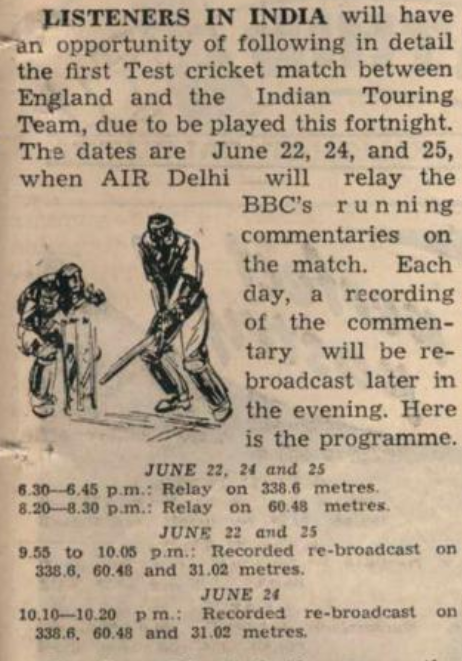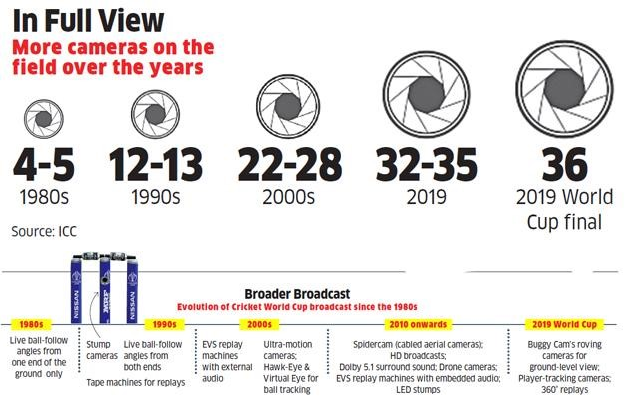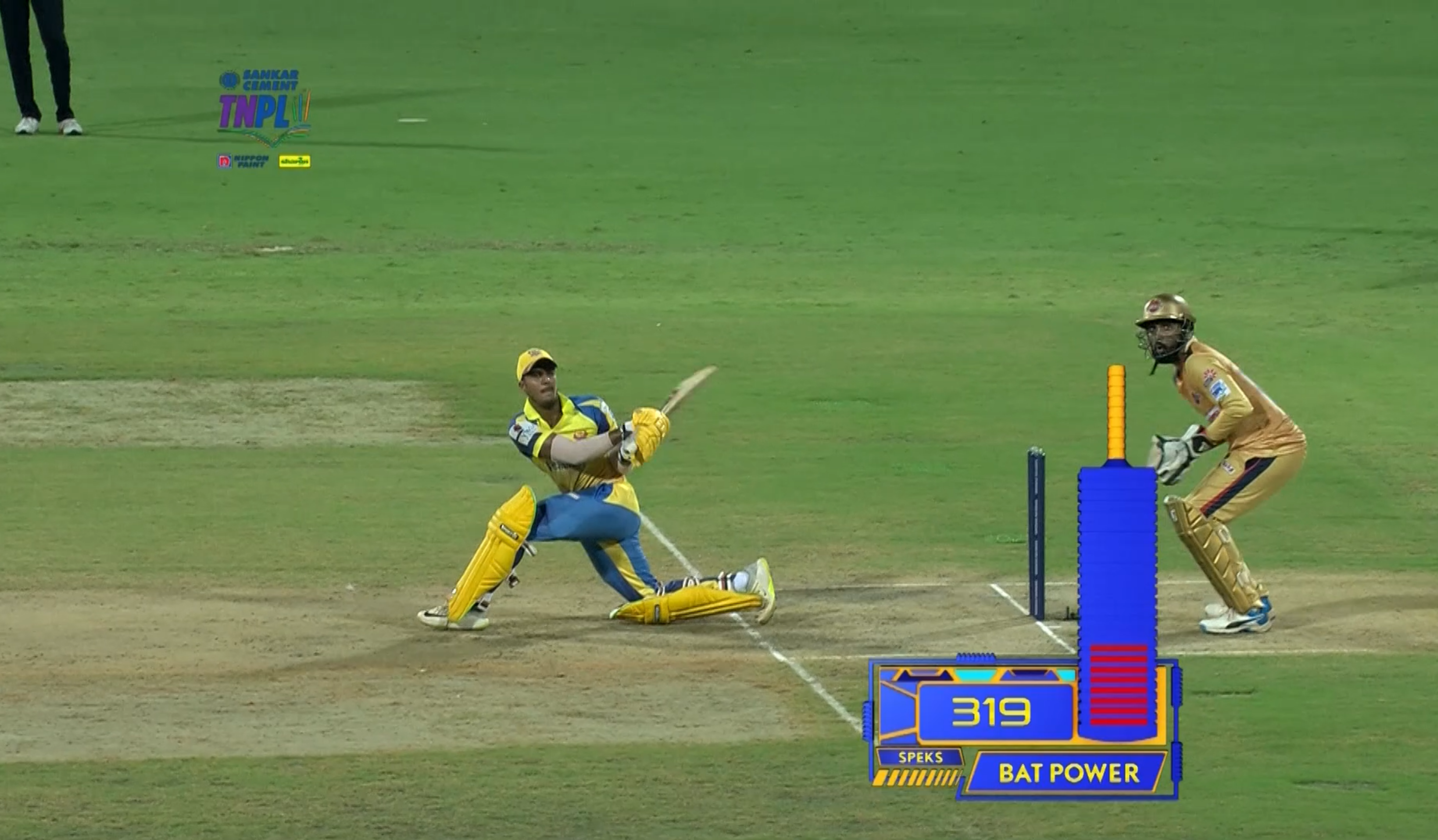
How TV Broadcasting Influenced Cricket?
It was the beginning of the summer of 1946 in England, and undivided India, under the captaincy of Iftikhar Ai Khan Pataudi, were all set to take on the mighty English at the Lord’s Cricket Ground. The BBC TV crew members were running helter-skelter to get the broadcast infrastructure setup for the match. It was a seminal moment. After a long pause, brought about due to the Second World War, cricket was all set to resume TV broadcasting. The jubilation was short-lived though. The video broadcast was allowed only for 3 hours per day and for only 3 days of the test match. Far from the expectations, the camera crew was provided access to only broadcast from the bird’s eye view of the cricket field. Unlike the BBC TV crew members, the cricket governing body was not enthused at the prospect of TV broadcasting. It was believed that the video broadcasting might dissuade the fans coming to the stadium and reduce their gate revenues. Back in India, the cricket fans could hear the match commentary only through All India Radio (AIR).

Cut to the end of summer of 2021 in England. The mighty Indians, who only recently missed an opportunity to grab the first edition of the World Test Championship against New Zealand, took on the English at the Lord’s cricket ground. There were cameras all around the boundary line, zooming in to cover every angle possible and every action on the cricket field. The entire match and commentary were relayed live to not just the television sets, but also through the internet to millions of desktops, laptops, tablets, and mobile phones. Fans from both sides of the continent compete with their own commentaries and analysis, flooding the social media with the broadcaster hashtags. At Lord’s, the stadium was jam-packed with fans from both teams. While the teams were intensely competing on the pitch, the viewers in the stadium were seen celebrating their togetherness with Mexican Wave movements.
Things had indeed changed.
The evolution of broadcasting in cricket:
Cricket made its first appearance in newspapers in the last decade of the 17th century, but it was only in the 1920s radio commentary made its beginning. The introduction of ball-by-ball commentary brought in a new form of storytelling to cricket - the story of a moving ball and the batsman’s ability to manage its trajectory formed the central theme of cricket commentary. When the first television broadcasting started in 1938 in England, it covered for only 20 Kms and for an estimated television viewers of only 7000 in the London area – no colour, no full match coverage, no replays, no multiple camera angles, and no highlights. In the early years of TV broadcasting, cricket was continuously viewed as a competition for attention with the stadium viewing and so was given lesser preference from the cricketing bodies.
Between then and now, cricket broadcasting has seen tremendous changes over the years. It was with the advent of commercial broadcasting, competitions became a regular feature in cricketing schedules. In 1968, the BBC introduced colour broadcasting; the dawn of colour jerseys began with the World Series Cricket introduced by Kerry Packer in 1977.
From around 4 to 5 cameras used in the 1980s, we now see more than 36 cameras for game coverage. From one end live coverage in the 1980s to stump cameras in the 1990s to Ultra motion, Hawk-Eye, 360-degree replays in the 2000s, we have seen numerous changes in the way cricket is broadcast today.

Cricket broadcasting not only immortalised cricketing stars and stories, but also paved the way for retired cricketers to find careers as commentators, analysers, and story presenters, across varied television and internet mediums. The role of a video analyst in the modern-day cricket could not have been envisioned without television broadcasting.
The evolution of advertising within broadcasting:
If broadcasting is the golden goose of cricket, advertising is the lifeline for TV broadcasting. In the initial years of broadcasting, advertising was largely restricted to what was seen on the stadium billboards, trophies, banners, and the intermittent television ADs during the match breaks.
When broadcasting started to understand the landscape of the viewer’s attention real-estate, the perimeter boards, sponsor logos in the ground, highlight packages, branded scorecards, etc., started occupying the screens. To build the association with the brands, the name of the brand names or their tag lines became adjectives for the branded package. With more infusion of digital technologies in broadcasting, computer graphics and virtual sponsor boards allowed for region-based advertising options during live matches.
With more global reach and stronger engagement, especially in the shorter formats of the game, in-play advertising started to gain traction. Ball speed measurements, boundary counters, and newer offerings like bat swing metrics provide increased in-play monetisation capabilities.
On the OTT platforms, user-interest based options are explored by broadcasters for personalized advertising. From one way communication, these new-age platforms also provide interactive ADs (Example: A user click on the AD screen can direct to the company app) for the advertisers. With more smartphone users watching matches on mobile, vertical-centric match broadcasting and advertisements are in the very near vicinity.
1. Format became a product:
Between 1877 and 1939, there were a total 99 timeless test matches played – a test match that was not restricted by the number of days. It was discontinued during the initial years of broadcasting owing to difficulties in scheduling and commercial arrangements.
To enhance entertainment quotient in the game, Kerry Packer introduced day-night matches, white ball cricket, colour jersey, multiple camera angles, on-screen graphics, etc., in the international arena with the World Series Cricket. Though it lasted only 2 years, it made a lasting impression on the cricket format.
When the cricketing community pondered on: How to bring the busy parents and 9-5 working class to engage with the game? The answer turned into a T20 product with a duration of 3 hours – mostly played in the late evenings.
How to make cricket even more entertaining and revive the interest among the youths in England? Bring in a new format with simpler rules - “The Hundred” on public broadcasting channel, with participation from the best players across the world.
How to sustain the following for Test cricket? Build a world championship format for Test matches.
2. Matches became battlegrounds:
Broadcasting works on the incentive of more and deeper. The more the audience, the better the reach for advertisement; the deeper the connect with the audience, the better is the monetisation capability. To engage viewers, you need to have strong heroes and a highly engaging story format. The story of how players overcame the odds, the story of matchups, the story of resilience, the story of aggression, etc., form the crux of broadcasting narration today. Naturally, competition came to dominate the format of the game. Matches are now projected as battlegrounds and players as superhumans fighting to win the games for their teams and the nations they represent.
3. Advertisers became sponsors and owners:
Until early 1990s, BCCI used to pay telecast production fee to Doordarshan for broadcasting matches. When the revenue generating potential of television advertising was understood, the model quickly reversed. The "ICC Cricket World Cup" as we know today was earlier named after sponsor brands like Prudential Cup (1975-83), Reliance Cup (1987), Benson & Hedges World Cup (1992), and Wills World Cup (1996). It was only in 1999, the series came to be officially known under the cricketing body. Even today, many of the bilateral tournaments and trophies are played under the official sponsor brand name. Many brands not only use cricket for sponsorship purposes, but also own teams as in the IPL and other leagues across the cricket playing nations.
4. Technology became fan engagement tools:
If you need to continuously enhance the fan engagement in the game, you need new forms of storytelling. Data and video analytics provide plenty of story angles for analysis by the commentators and fans - zones of strength and weakness, player battles, etc., engages the fan well beyond the actual game. Technology like stump camera with mic helps to capture the key moments on the pitch. Camera angles through Spidercams and Buggy cams enable continuous tracking of players and ball movements. Newer technologies like ball tracking and bat swing analysis (Spektacom PowerBat) enable viewers to dissect the action behind a cricket shot.

Computer graphics, replays, and slow-Mo camera feeds allow the viewers to etch the moment into their cricketing memory. LED bails provide an extra entertainment quotient even during a wicket. DRS tech not just enhanced umpiring outcomes, but also allowed the fans to don the hat of a third umpire.
5. Fans became contributors of the cricketing story:
With rapid adoption of social media and OTT platforms, cricket fans also moved up the value chain, from being consumers to contributors of the cricketing story. With cricketers becoming celebrities, their offline way of conduct also became an integral part of storytelling by fans. Today, the story of a cricket shot does not end with the commentator’s point of view, nor within the duration of the game, it organically passes through thousands of analyses from fans across multiple social platforms. Fans also transform as commentators for fellow viewers in live OTT platforms and match analysers in social media platforms.
An ever-expanding journey:
Cricket has evolved through the ages. From the days when crowds used to gather to watch matches in retail TV shops to watching it solo at the comfort of their device and place, the evolution even in video broadcasting had been exponential. The unstated goal of broadcasting has been to provide a cricketing viewing experience that might be of envy even to the stadium audience. Despite the initial reservations of broadcasting, it had enabled a wider reach for cricket and brought more people to throng the stadiums as well. One of the biggest influences of broadcasting is not in the changes it brought, but the connect it was able to establish for cricket with its audience and their aspirations from the game. With match broadcasting expected to penetrate into interactive gaming platforms in the near future, the story of cricket is set to expand further in scope and farther in reach.
References:
https://www.espncricinfo.com/story/a-brief-history-214571
https://www.ibc.org/interviews/sundar-raman-learn-to-innovate-like-live-cricket/3974.article
https://economictimes.indiatimes.com/news/sports/how-the-broadcast-of-icc-cricket-world-cup-has-changed-over-the-past-four-decades/articleshow/70207995.cms
https://openthemagazine.com/sports/how-cricket-was-sold-in-india/
https://dspace.stir.ac.uk/bitstream/1893/10281/1/Cricket%20and%20broadcasting%20review.pdf
https://en.wikipedia.org/wiki/Cricket_World_Cup#Tournament_records
The Early Courtship of Television and Sport: The Case of Cricket, 1938-56. Richard Haynes | Journal of Sport History, Fall 2009, Volume 36, No. 3, 401 - 417.


Comments